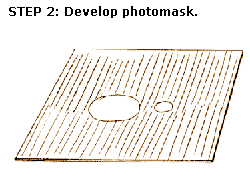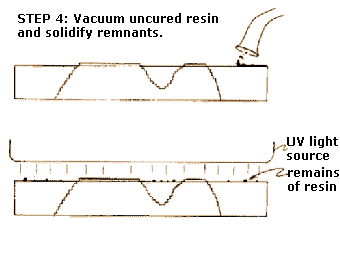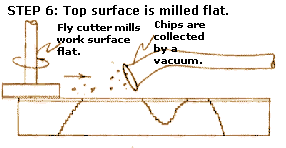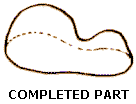Solid Ground Curing
Highlights of Solid Ground Curing
•Large parts, 500 × 500 × 350 mm (20 × 20 × 14 in), can be fabricated quickly.
•High speed allows production-like fabrication of many parts or large parts.
•Masks are created w/ laser printing-like process, then full layer exposed at once.
•No post-cure required.
•Milling step ensures flatness for subsequent layer
•Wax supports model: no extra supports needed.
•Creates a lot of waste.
•Not as prevalent as SLA and SLS, but gaining ground because of the high throughput and large parts.
Solid Ground Curing: An Introduction
Solid Ground Curing, also known as the Solider Process, is a process that was invented and developed by Cubital Inc. of Israel. The overall process is illustrated in the figure above and the steps are illustrated below. The SGC process uses photosensitive resin hardened in layers as with the Stereolithography (SLA) process. However, in contrast to SLA, the SGC process is considered a high-throughput production process. The high throughput is achieved by hardening each layer of photosensitive resin at once. Many parts can be created at once because of the large work space and the fact that a milling step maintains vertical accuracy. The multi-part capability also allows quite large single parts (e.g. 500 × 500 × 350 mm / 20 × 20 × 14 in) to be fabricated. Wax replaces liquid resin in non-part areas with each layer so that model support is ensured.

Solid Ground Curing Process
The steps in the process are as follows.
First, a CAD model of the part is created and it is sliced into layers using Cubital's Data Front End® (DFE®) software. At the beginning of a layer creation step, the flat work surface is sprayed with photosensitive resin, as shown below:

For each layer, a photomask is produced using Cubital's proprietary ionographic printing technique, as illustrated below:

Next, the photomask is positioned over the work surface and a powerful UV lamp hardens the exposed photosensitive resin:

After the layer is cured, all uncured resin is vacuumed for recycling, leaving the hardened areas intact. The cured layer is passed beneath a strong linear UV lamp to fully cure it and to solidify any remnant particles, as illustrated below:

In the fifth step, wax replaces the cavities left by vacuuming the liquid resin. The wax is hardened by cooling to provide continuous, solid support for the model as it is fabricated. Extra supports are not needed.

In the final step before the next layer, the wax/resin surface is milled flat to an accurate, reliable finish for the next layer:

Once all layers are completed, the wax is removed, and any finishing operations such as sanding, etc. can be performed. No post-cure is necessary.


